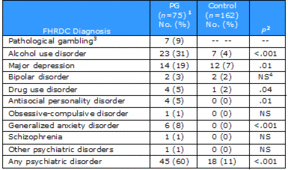The Wager, Volume 8(11) – All in the Family: PG and the Role of Family History
Some scientists speculate that disordered gambling is more prevalent in families with a history of disordered gambling behavior. In an effort to assess the familial genetic relationships of pathological gambling and other psychiatric disorders, Black, Moyer, and Schlosser (2003) analyzed both familial and personal data of pathological gamblers and healthy control subjects. This week’s WAGER presents the family results of this study.
Black et al. recruited individuals who gamble problematically through newspaper ads and news releases. The final study group consisted of thirty participants (21 male) who met the South Oaks Gambling Screen [SOGS; (Lesieur & Blume, 1987)] criteria for probable pathological gambling (i.e. PGs). Participants completed a battery of diagnostic assessments, including the National Institute of Mental Health Diagnostic Interview (DIS) revised for compatibility with DSM-III-R (Robbins, Helzer, Cottler, & Goldring, 1989), and several self-report questionnaires including the Beck Depression Inventory [BDI; (Beck, 1978)]. A subset of 14 participants completed the Family History Research Diagnostic Criteria [FHRDC; (Andreasen, Endicott, Spitzer, & Winokur, 1977)] to provide psychiatric information about immediate family members.
Table 1. Diagnoses of First-Degree Family Members of PG and Healthy Subjects (Black et al., 2003)

1 n = number of relatives reported on by study participants.
2 Fisher’s Exact Test was used.
3 The FHRDC has no criteria for PG. These subjects were identified
through the use of criteria designed by the authors. No comparative
gambling data were collected for relatives of control subjects.
4 NS = non-significant.
Using Fisher’s Exact Test, the authors compared the familial information collected from the study group (n=14) with data from a control group (n=22) recruited for a parallel study. Members of the control group were required to be free of psychoses, substance abuse disorders, neurological conditions, etc., and were screened accordingly. Table 1 presents the prevalence of disorders among PG and control-group relatives and the significance of the differences (p) between groups. Immediate relatives of disordered gamblers were more likely to have alcohol use disorders, major depression, drug use disorders, antisocial personality disorder, and a variety of other disorders. Additionally, of 75 relatives identified by problem gamblers, 7 (9%) were reported as exhibiting disordered gambling behaviors.
While these results appear to place close relatives of problem gamblers at increased risk for a wide range of conditions, several methodological limitations of the study must be considered. For example, the small sample sizes of both the study and control groups might have produced trends that are uncharacteristic of the population as a whole. In addition, the authors did not explain why they asked only a subset of the 30 participants to answer the FHRDC questions. The sampling design (i.e., self-response to an advertisement as opposed to random sample) potentially promotes overestimation of significant differences between the groups by including subjects that may be sicker (study group) and healthier (control group) than the wider population, especially since the control group was specifically required to be mentally fit. Further, the possibility exists that the data collected on family members was biased or inaccurate, since this information was provided second-hand rather than through direct psychiatric evaluations. The authors did not define “first-degree relative” as used in the study, making it impossible to define the composition of the relative sample. Finally, because no information on relatives’ gambling habits was presented for the control group, there is no basis for comparison for the 9% of PG relatives found to have a gambling problem.
By placing their focus on hereditary links to disordered gambling, Black et al. call attention to the importance of family history in understanding gambling disorders. The continued study of genetic trends in disordered gambling will allow science to further understand the traits and behaviors of problem gamblers, and might ultimately lead to preventative strategies for those who are at risk.
Comments on this article can be addressed to Tony Donato.
Notes
* The Family History Research Diagnostic Criteria (FHRDC) is an instrument that is designed to collect family psychiatric information through interviewing a single family member (i.e., the study participant). The instrument includes diagnostic criteria for 12 psychiatric disorders.
References
Andreasen, N. C., Endicott, J., Spitzer, R. L., & Winokur, G. (1977). The family history method using diagnostic criteria. Archives of General Psychiatry, 34, 1229-1235.
Beck, A. T. (1978). Depression inventory. Philadelphia: Philadelphia Center for Cognitive Therapy.
Black, D. W., Moyer, T., & Schlosser, S. (2003). Quality of Life and Family History in Pathological Gambling. Journal of Nervous & Mental Disease, 191(2), 124-126.
Lesieur, H. R., & Blume, S. B. (1987). The South Oaks Gambling Screen (SOGS): A new instrument for the identification of pathological gamblers. American Journal of Psychiatry, 144(9), 1184-1188.
Robbins, L. N., Helzer, J. E., Cottler, L. B., & Goldring, E. (1989). National Institute of Mental Health Diagnostic Interview Schedule, version 3, revised. St. Louis: Washington University, Dept. of Psychiatry.